
Asexual Reproduction
How Do Organism Reproduce of Class 10
Production of offsprings by a single parent without the formation and fusion of gametes is called as asexual reproduction. It is more primitive type of reproduction. It ensures rapid increase in number.
Characteristic
- It involves only one parent and no formation of gametes.
- The offspring produced is direct replica of the parent leaving no scope for variation.
- This is also called as vegetative or somatic reproduction and common in plants and lower animals
- Occurs by budding, binary fission, multiple fission, sporulation and also the regeneration.
- Protozoans, sponges and coelenterates reproduce mainly by this way.
TYPES OF ASEXUAL REPRODUCTION:
1. Binary fission – Amoeba, Euglena, Vorticella
2. Multiple fission – Amoeba, Plasmodium, Monocystis
3. Plasmotomy – In multinucleate protozoans e.g.opalina, Pelomyxa.
4. Exogenous budding – Hydra, Syllis, Salpa
5. Internal budding or – Spongilla, Few marine sponges by Gemmule formation
6. Fragmentation – Asterias(Star fish)
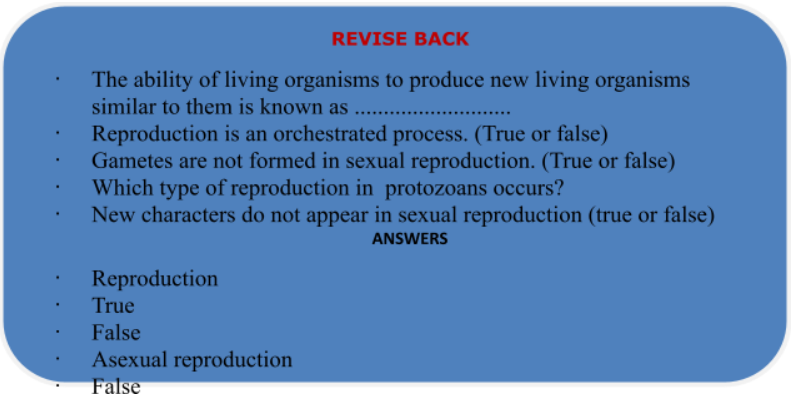
TYPES OF ASEXUAL REPRODUCTION
(i) Fission:
It is the simplest form of reproduction in which unicellular organism either divides into two or many organisms.
It is also divided into two types:
- Binary fission: Binary fission, meaning "division in half", refers to a method ofasexual reproduction. It is the most common form of reproduction inprokaryotesand occurs in some single-celled eukaryotes. After replicating its genetic material, the cell divides into two equal sized daughter cells. The genetic material is also equally partitioned, therefore, the daughter cells are genetically identical (unless amutationoccurred during replication) to each other and the parent cell. Transverse binary fission divides the cell across the short axis (e.g., most bacilli-shaped bacteria), longitudinal binary fission across the long axis (e.g.,Trypanosoma), and random binary fission across no defined axis (e.g.,Amoeba). Some biologist use this term for multi-cellular organisms that asexually reproduce by dividing into two (e.g., some star fish). This is also known as fragmentation. Spirogyra, a type of algae also reproduces by binary fission.
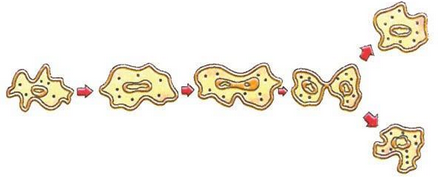
Binary fission in Amoeba
- Multiple fission: Sometimes the nucleus divides several times, into many daughter nuclei. The daughter nuclei arrange at the periphery of the parent cell, and a bit of cytoplasm around each daughter nuclei is present. Nucleus develops an outer membrane. Finally the multi-nucleated body divides into many daughter cells. e.g. Plasmodium.

Reproduction by multiple fission
- Budding: Formation of a daughter individual from a small projection which is called as bud, arising on the parent body is called as budding.
Budding is also of two types:
Exogenous budding: [External budding] In this, bud arises from the surface of parent body. e.g., Hydra.
Budding in Hydra: A bulge appears on the body as a result of repeated mitotic division in the cells resulting in the formation of lateral out-growth called bud. This bud enlarges in size by further division of cells and attains the shape of parent. It then separates from the parent body and starts behaving as new Hydra.
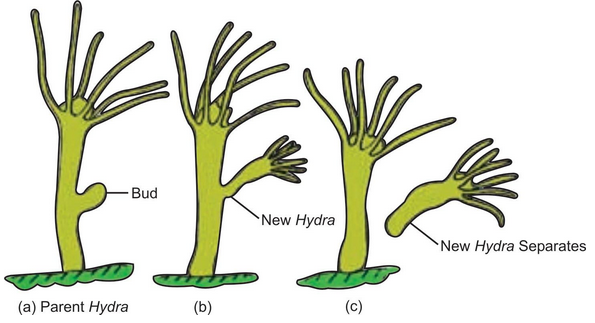
Budding in Hydra
Endogenous budding: [Internal budding] In this, bud arises inside or within the parent body. e.g., Sponges.
Budding in yeast: A small bud like out-growth appears at one end of the parent cell which gradually enlarges in size. The nucleus also enlarges and divides into two daughter nuclei. One nucleus remains in the parent cell and other goes to the daughter. When the bud attains almost similar size like parent, a constriction appears at the base of the bud separating it from the parent. However, sometimes a chain of buds can also be seen.
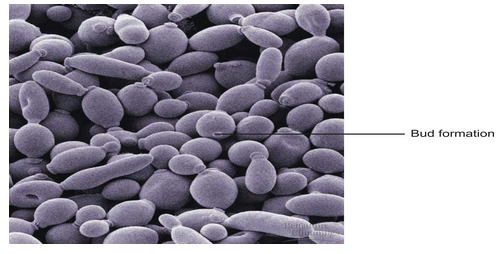
Budding in Yeast
|
|
During the process of budding, the bud remains attached to the parent body so as the derive it’s nutrition from the parent but as it matures, it gets detached from the parent body. |
Fragmentation: It is a type of reproduction or the regeneration ability of the organism to replace their lost part. In this process an entire new organism can grow from certain pieces or of the parent organisms. e.g. Flatworm.
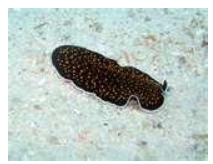
Example: define asexual reproduction in fungi.
Answer : Fungi reproduce asexually by means of sporulation and fragmentation.
Fragmentation :
This is a type of asexual reproduction in fungi which is similar to the vegetative reproduction in some plants. In this process, a detached fragment of the fungal hyphae gives rise to a new individual under suitable conditions.
Sporulation :
In fungi, other than yeasts, the most common type of asexual reproduction is sporulation. The process of formation of spores is called sporulation. . The spores formed in sporangia are called sporangiospores which are formed by several mitotic divisions. Asporangiospores germinate to develop into an organism with many vegetative hyphae.eg: mucor
Conidia :
In this process the fungal hyphae differentiate into structures like sporangia, conidiophoresetc., which will give rise spores or condidia by mitotic division. eg: Asperigillus
Spore formation:
A spore is a single or several-celled reproductive structure that detaches from the parent and gives rise, directly or indirectly to a new individual.
Spore formation takes place mostly in bacteria and fungi. In fungi e.g. Rhizopus, Mucor, Aspergillus, Penicillium etc., spores are formed in a sac-like structure called sporangium at the tips of fungal hyphae. The nucleus divides inside the sporangium and gets surrounded by a small mass of cytoplasm forming a spore. After attaining maturity, the sporangial wall ruptures releasing the spores. The spores are covered with thick walls that protect them until they come in contact with another moist surface and can begin to grow.
|
|
These spores can be non-motile called aplanospores or motile called zoospores. |
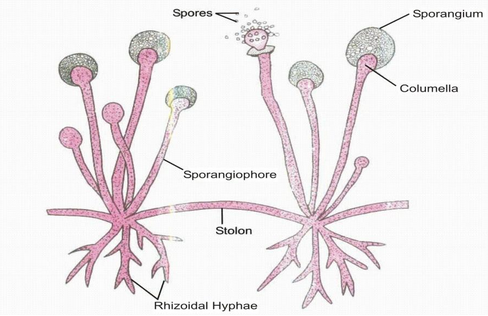
Formation of sporangia and spores in a fungus (Rhizopus)
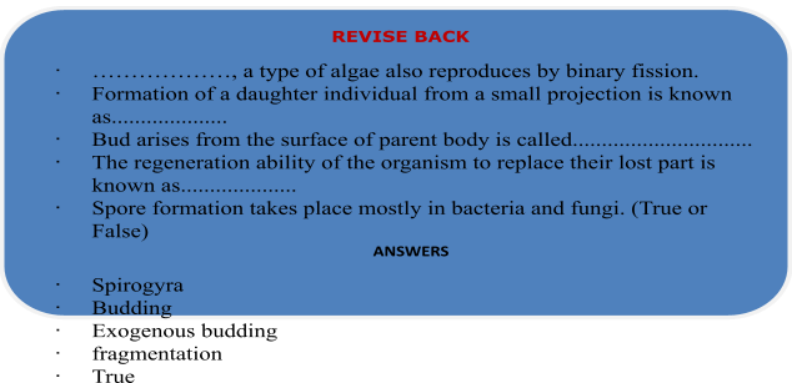
Regeneration
Regeneration is defined as a natural ability of some simple multicellular organisms to replace worn out parts, to repair damaged parts or to regrow cast off organs. It takes place mostly in Hydra, Planaria, sponges, etc. If sometimes the individual is somehow cut or broken into many pieces, many of these pieces grow into separate individuals. But regeneration is not same as reproduction since most organisms would not normally depend on being cut up to be able to reproduce.
Regeneration is performed by specialised cells. These specialised cells proliferate and make large number of cells. Different cells from the mass of cells undergo change to become various cell types and tissues. These changes takes place in an organized sequence referred to as development. Complex multicellular organisms cannot give rise to new individuals by regeneration. This is because they have complex body organization.
Vegetative propagation: Plant undergoing vegetative reproduction propagates by a part of their body other than a seed. This part is called propagule. Vegetative reproduction is of different types.
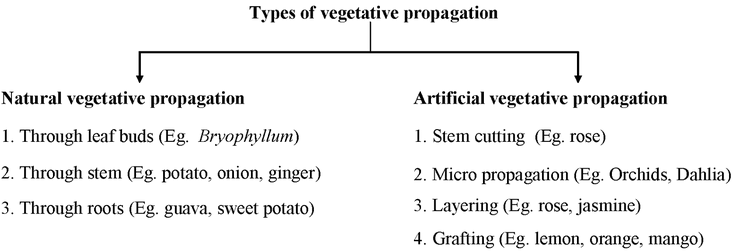
Natural method: There are many plants which propagate naturally. Some plants propagate by roots e.g. sweet potato, guava, etc.; some by stems like ginger, banana, potato, strawberry; etc.; some by leaves like Bryophyllum, Begonia, etc.
Artificial method: There are some plants which propagates artificially by following methods :
Cutting: This is the very common method of vegetative propagation practised by the gardeners all over the world. It is the process in which a vegetative portion from plant is taken and is rooted in the soil to form a new plant. e.g. Grapes, Sugarcane etc.
Layering: In this process the development of adventitious roots is induced on a stem before it gets detached from parent plant, e.g., Mango, roses etc
It is of three types:
Mound layering: In the process of layering the lower stem branch of plant is used. Leaves are removed from this stem. Then it is bent close to the ground, pegged and covered with the moist soil in such a way that it's growing tip remains above the soil surface. This pegged down branch is called as layer. After a few days the covered portion of stem develops roots. This stem is then detached from the parent plant and is grown separately into a new individual. e.g. Jasmine
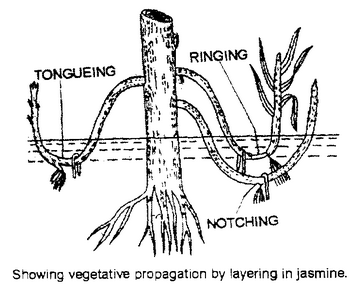
|
|
The formation of adventitious roots in a layer can be hastened by injuring the 'layer' by tonguing, ringing or notching. |
Air layering: It is adopted in those plants where stem cannot be bent to the ground. In this process the stem is girdled (i.e. ring of the bark is removed). Then it is covered with moist moss or cotton and wrapped with a polythene sheet to preserve the moisture. After few weeks adventitious roots develop from the injured part. The branch along with roots is then separated from the parent plant and planted to grow into a new plant. e.g. Orange, Pomegranate etc.
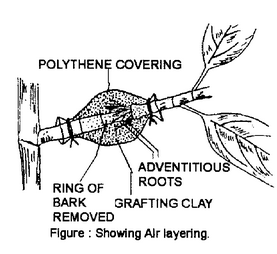
Grafting: The process of joining together of two different plants in such a manner that they live as one plants is called as grafting. Out of the two plants one is rooted in the soil and is known as the stock. The other part consists of a small shoot bearing one or more buds it is known as scion. Their union is carried out in such a way that their cambium must overlap each other. e.g. Mango, roses etc.
Methods of grafting.
There are four methods of grafting. They are
- Approach grafting
- Cleft grafting (or) Wedge grafting
- Tongue grafting
- Bud grafting
Approach grafting : Ex: sapota, Mango, Guava etc.
- In this method both scion and stock remain rooted. A small slice is cut off from the stem of scion and stock.
- Scion is bent towards the stock. The two cut surfaces of the scion and stock are brought together and tied with a tape.
- In course of time the two stems get united. Then the top of the stock and the base of the scion are cut off.
Cleft grafting (or) wedge grafting
- The stem of the stock is cut across. A 'V' shaped insertion is made at the end of the stock.
- The scion is cut in shape. The scion is inserted into the 'V' shaped root stock. The point of union is held in position and a waxed tape is put around the junction.
Tongue grafting : This method is used on stocks that are relatinely small.
- Top of the stock is cut diagonally and in an upward direction. Scion is cut diagonally in downward direction.
- A second cut is given from above downwards, which forms the tongue, such that the notch or tongue of the scion closely fits with that of stock.
- Union is tied with twine and covered with a waxed tape.
Bud grafting : Ex. Apple, orange, rose etc.
1. A 'T' shaped incision is made on the bark of the stock.
2. A bark is removed on either side of vertical cut.
3. A single bud scion with a little wood is placed in the incision of below the bark and held in position applying tape.
Advantage of vegetative propagation.
1. Vegetative propagation helps to maintain fixed qualities and characteristic features of the parent plant.
2. For Example in ornamental plants with attractive flowers and leaves or any other interest ingvariatiion in one plant can be continued in next generation through vegetative propagation.
3. Such plants can be produced in large numbers in a short time.
4. Vegetative reproduction offers uniform root stock for budding or grafting.
5. This root stock can be selected from a plant that is immune to diseases.
6. In this method it would be possible to develop new varieties with useful characters.
7. It can be used to grow other varieties by means of grafting.
8. Vegetative propagation is a very useful method of reproduction in plants that rarely pro duce flowers.
Micro propagation: It has now become possible due to recent techniques to produce a large number of plantlets from a small piece of tissue taken from the shoot tip or other suitable plant parts. This method of propagation is called as micro-propagation. It involves the process of tissue culture. e.g., Orchids. ornamental plants etc.
Mechanism of micro propagation:
- A small piece of plant tissue placed in a culture medium divides rapidly to form a shapeless lump called ‘callus’.
- The callus is then placed in different culture media to stimulate the development of root and shoot.
- Tiny plantlets are formed from just few cells which are transplanted into pots or soil where they can grow to form mature plants.
Advantages of micro propagation
- It is a fast technique producing many plantlets from a small plant tissue in few weeks and using very little space. In other words, it is quite economical.
- The plants produced by tissue culture are disease free.
Significance of vegetative propagation
(A) It is used to propagate a plant in which viable seeds are not formed or very few seeds are produced. e.g. Orange, pineapple, banana etc.
(B) Vegetative propagation helps us to introduce plants in new areas where the seed germination fails to produce mature plant due to change in environmental factors and the soil.
(C) Vegetative propagation is a more rapid, easier and cheaper method of multiplication of plants.
(D) By this method a good quality of a race or variety can be preserved.
(E) Most of the ornamental plants are propagated through vegetative propagation. e.g. Rose, Tulip etc.
Significance of asexual reproduction:
The significance of asexual reproduction is that it is a means for a rapid and significant increase in the numbers of individuals. (Weeds, for instance, are successful partly because of their great capacity for vegetative reproduction.) The cells that result from asexual reproduction are genetically identical to their parent cells. In addition, vegetative reproduction in the bryophytes and pteridophytes is a means of bypassing the somewhat lengthy and moisture-dependent sexual process; that is, the motile swimming sperm characteristic of these groups require the presence of water, which may be a limiting factor in drier times.
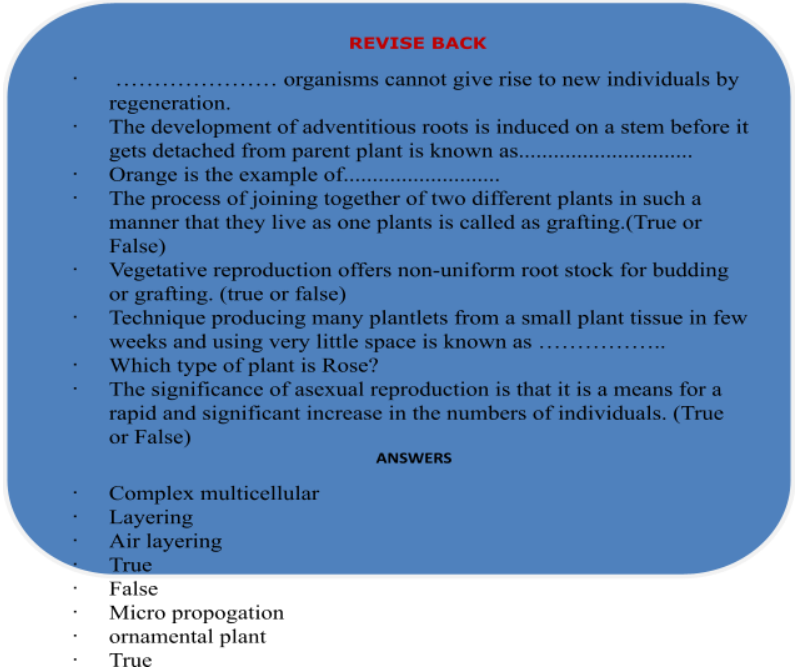

.png----FileNotFound----)





